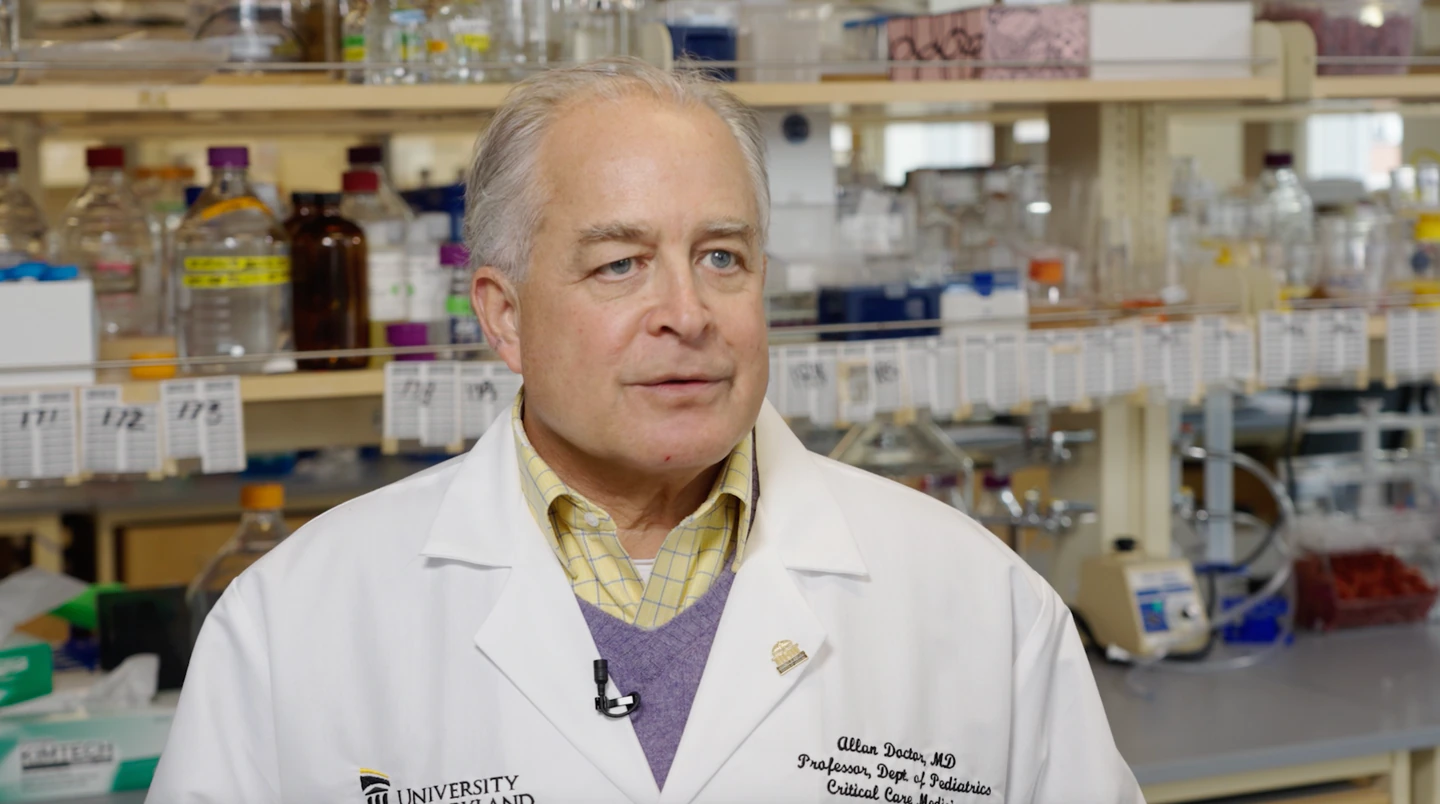Many Shooting Victims Bleed Out. Baltimore Researchers Want to Improve their Chances

Published in the Baltimore Banner on February 13, 2023
Two physician-scientists at the University of Maryland medical school are testing radically different ways to stem the catastrophic blood loss that often kills trauma victims — one by using a Tang-like, artificial blood powder and another by inducing hypothermia.
While the researchers’ methods diverge, their goal is the same: to buy enough time to surgically repair patients’ wounds and administer lifesaving treatment before they bleed out, thus boosting their chances of survival.
Most victims of severe trauma, such as gunshots, stabbings, or other injuries will die of blood loss long before they succumb to the damage caused by their wounds. Only 5% of patients who suffer cardiac arrest from traumatic bleeding will survive, said Samuel Tisherman, director of the surgical ICU at the University of Maryland Medical Center and lead researcher for one of the studies, which could conclude as soon as this year.
Allan Doctor, lead researcher of the other study and director of the Center for Blood Oxygen Transport and Hemostasis at the University of Maryland School of Medicine, said between 20,000 and 25,000 people in the U.S. who suffer severe trauma will die of blood loss before ever reaching the hospital. His team is developing an artificial blood product that can be administered to patients “at the point of injury,” whether that’s the site of a motor vehicle accident or the scene of a shooting. In Baltimore, gun-related deaths have hovered around 300 for the last eight years.
The blood product will be shelf-stable for long periods of time and able to withstand extreme temperatures, Doctor said, whereas real human blood must be kept refrigerated and has a shelf life of just 42 days. This is why transfusions don’t take place “in the field,” or in ambulances, he said, because the right storage conditions aren’t practical and blood is both too scarce and too needed to risk wasting.
Doctor and his team recently received $46 million in funding from the Defense Advanced Research Projects Agency, the research arm of the U.S. Department of Defense, for a four-year project to develop and test artificial blood, with the idea that it can be used to save soldiers with combat injuries. Researchers must design the product to be portable and user-friendly enough that it can be stored in a backpack and administered by a soldier “who’s had like a month of basic medic training,” Doctor said.
The blood product will take the form of a dry powder “like Nescafé or Tang,” Doctor said, and it will come in a package that can be twisted or “snapped” — similar to a portable hand-warmer or ice pack — to disperse the liquid and turn the powder into blood that can be quickly transfused.
:quality(70)/cloudfront-us-east-1.images.arcpublishing.com/baltimorebanner/7FIDDLEHBJBYVAWB46JPBNXFGY.jpg)
The artificial blood is intended to help keep an injured person alive until they can reach a hospital where they can access real blood, undergo surgery, and receive other care. The artificial blood will eventually “clear the body,” as replacement blood is produced by the bone marrow, Doctor said.
The first year of the newly-begun study will be dedicated to formulating the blood product itself, with animal testing to commence in year two. The product must perform at least 90% as well as real blood by the end of year four, and the team must meet other milestones related to efficient production and practical use of the product. Then, they can submit an application to the FDA to begin clinical trials in humans.
They’ve already begun communicating with the FDA, Doctor said. The agency will need to create a whole new category and regulatory structure for the “nanotherapeutic artificial cell” they’re designing, he said, as nothing similar has ever been produced.
Though the blood product will be designed with military combat use in mind, it could be used by civilian paramedics and may be particularly helpful following mass casualty events, such as the Boston marathon bombing, when cities run out of banked blood, or in developing countries with high rates of disease, such as hepatitis or malaria, which render much of the blood supply unusable. Austere environments, such as Mount Everest or Antarctica, present another opportunity for use.
Doctor says NASA has expressed interest in eventually using the product for space missions. “There’s no ‘get to the hospital’ if you’re in space,” he said. “It’s just ‘hold pressure’ and hope you don’t die.”
A life-saving freeze?
Some trauma victims do make it to the hospital but suffer cardiac arrest from blood loss minutes prior to arrival or after they get there. Tisherman leads a team testing another novel, but perhaps counterintuitive, way to buy them time.
The procedure is called emergency preservation and resuscitation, or EPR. A medical team induces hypothermia in the trauma victim by pumping the body with icy saline and quickly lowering its temperature to 50 to 60 degrees Fahrenheit. This places the patient in a state of so-called “suspended animation” where the brain’s need for oxygen supplied by blood flow is reduced.
Normally, when the heart stops pumping for lack of blood the brain will be irreparably damaged after about five minutes fromthe drop inoxygen. A rapid plunge into hypothermia means the brain’s metabolism is slowed down quickly and dramatically enough to preserve its functioning for a time without circulation.
When performing EPR, Tisherman and team keep the patient in a hypothermic state for up to an hour while trauma surgeons rush to fix their wounds. They are revived afterward with gradual warming, a lot of fresh blood, and a heart-lung machine to pump it throughout the body. The patient is then weaned off the machine and taken to the ICU.
Tisherman and other researchers spent decades proving EPR could work on dogs and pigs with minimal aftereffects and no brain damage. In 2016, the FDA granted permission for a study on humans — 10 trauma victims who receive EPR treatment will be compared to 10 who do not. All participants will have either suffered a gunshot wound or stabbing, though Tisherman said the procedure can likely be used on patients with “blunt” trauma in future.
When trauma victims who meet the study criteria are not given EPR, itis simply because the right team is not immediately available to administer it, Tisherman said. The procedure requires coordination of trained staff that don’t normally work together, he said, and if one piece of the puzzle is missing or tied up with something else, that patient is assigned to the control or comparison group.
The study is still ongoing, in part because of a long pandemic-driven pause. EPR has been performed on some patients at the University of Maryland’s Shock Trauma Center, though Tisherman wouldn’t say how many or what the outcomes have been. Because the study is small, incomplete results wouldn’t say much.Tisherman did say that patients have been successfully cooled and the resuscitation has been perhaps more challenging than expected.
Tisherman hopes to conclude the study by the end of this year or in 2024, and will then release results. If the procedure is deemed feasible and beneficial for saving lives, the next step could be to conduct a larger, multi-center study to see if it can be used in other hospitals that may not have the technology and “high-level staffing” that Shock Trauma has, Tisherman said.
Eventually, if smaller pumps and cooling devices could be developed and emergency responders suitably trained, EPR could potentially be used outside of the hospital, like the artificial blood product Doctor and his team are developing, Tisherman said. Or, the two methods could potentially be used in tandem. Tisherman cautions this is “way down the road” and would require a lot of additional research, but “there’s definitely some overlap in terms of potential” for the two techniques, he said.
Still, the technique could save a significant number of lives, he said. Tisherman’s goal is to at least double the survival rate of trauma victims with profound blood loss from the current 5% to 10% by performing EPR. Gunshot and stabbing victims are typically young and otherwise healthy, he said, and “if we can get them through this, it’s huge.”



